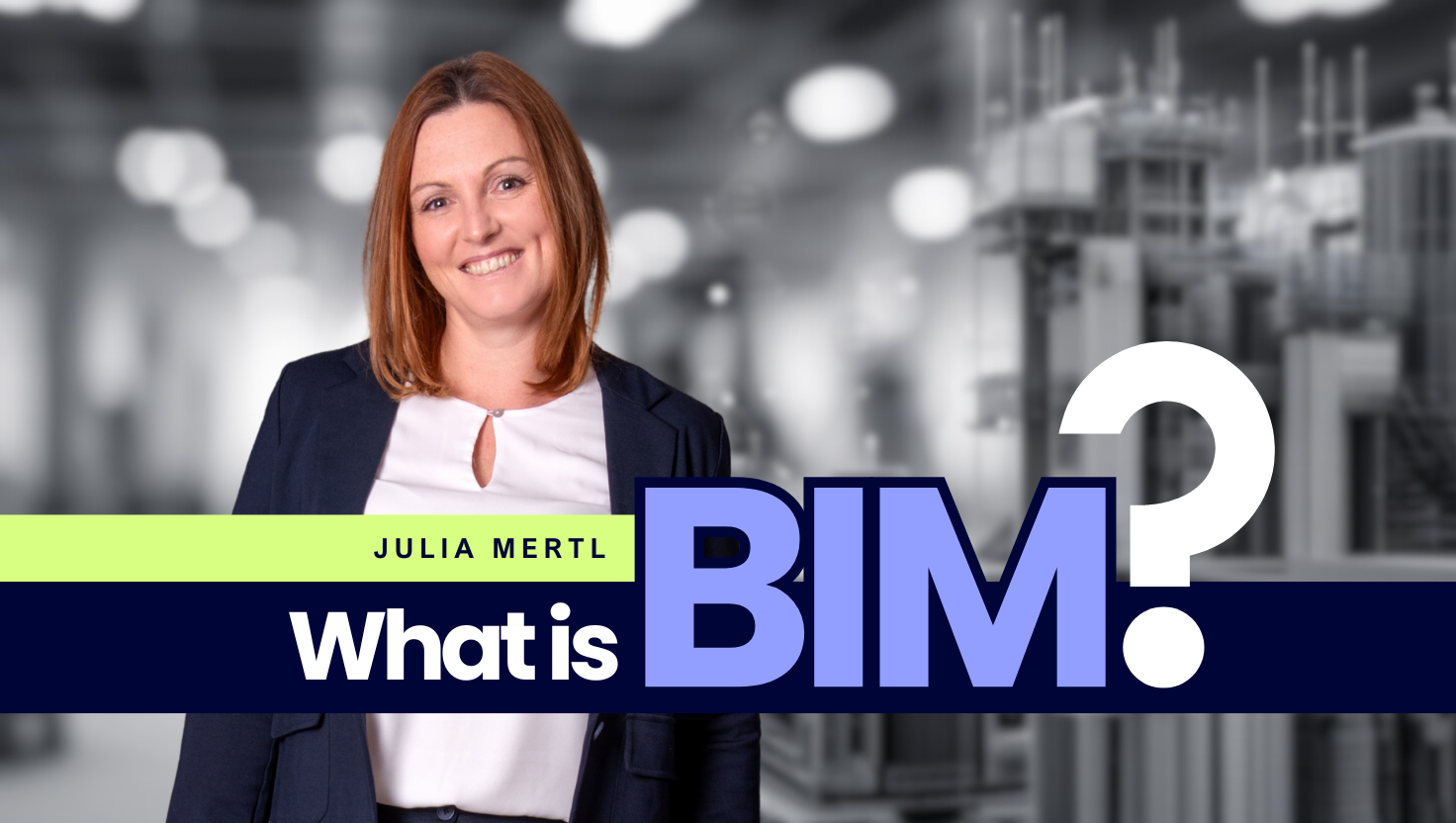What is BIM - A personal experience report from construction management
by Julia Mertl | July 1st, 2025
When you work in controlling for a large general contractor for years, you have a good overview of construction projects – at least from the perspective of figures, budgets, deadlines and risks. I’ve seen a lot: Chaotic project starts, insane missed deadlines, surprising supplements, unclear responsibilities, poorly documented construction site reality. What I didn’t see for a long time, however, was the digital revolution in construction, and specifically Building Information Modeling – BIM for short.
I was familiar with the term, but for a long time BIM was nothing more than an empty buzzword that was mainly used by architects, IT-savvy and visionary engineers or start-ups. In the minds of many colleagues – including mine – it was seen as a technical nice-to-have, not a serious method for day-to-day project work. I thought: “This won’t get us any further in real day-to-day project work, especially not when it comes to the commercial aspects of a project.”
What is BIM?

Let’s start from the beginning: BIM stands for Building Information Modeling. The term can be translated into German as “building data modeling”, but this hardly captures what BIM is really capable of. This is because BIM is not a single software tool, a pure 3D drawing or a simple visualization tool. It is a digital, integrative process in which all relevant information about a building is centrally modeled, recorded, networked and used throughout the entire life cycle – from planning and construction to operation and dismantling.
Instead of isolated plans, Excel spreadsheets, email folders and verbal agreements, the BIM process has a central, digital model that all participants use as a common data source. This is also referred to as a single source of truth – a central truth about the project that is shared by everyone involved.
This model therefore not only contains geometry (3D), but also information such as materials, costs, schedules, sustainability data, manufacturer specifications and much more. This creates a digital reality of the building.
My professional home for a long time was controlling. Only hard facts count there, not bling-bling. Of course, I often heard that BIM was being used in planning or on the construction site. But my assumption was: “That doesn’t affect us. Let them do it. There’s no added value for me”
Looking back, I realize how much I – and many others – only understood BIM as a tool for individual specialist areas. What I lacked was an understanding that BIM is an overarching management approach. It’s not just about software, but about new ways of thinking: networked, collaborative, forward-looking.
What made me change my mind?

It was not a single moment, but a development: I saw how many mistakes happen in projects and that they always have the same causes: poor communication, outdated information, media disruptions, lack of transparency.
I increasingly asked myself: Why do so many construction sites always run in the same chaotic way?
The answer: Because we continue to work as we did 20 years ago. With folders, plans, Excel lists and the saying “We’ve always done it this way.”
It was only when I changed jobs and immersed myself in a completely new world of “working in construction” that I began to understand the potential that BIM has to break these patterns. I have realized: BIM is not just a planning issue. It is a tool to raise efficiency, quality, transparency and collaboration to a new level and has the potential to break established patterns. Exactly what modern construction projects need today.
BIM and Lean - two strong approaches, one common goal

BIM became particularly exciting for me when I started to combine it with lean construction. Lean construction is not a new concept in the construction industry, it aims to minimize waste and optimize processes – a philosophy that fits perfectly with BIM.
After all, BIM provides the digital basis for truly implementing lean on the construction site: With precise processes, realistic simulations, clear responsibilities and the ability to visually plan, analyze and control the construction process. By combining BIM with time data, construction processes can be planned, visualized and optimized to the exact date.
One example: by linking BIM with the schedule (4D), it is possible to simulate exactly what a construction process looks like day by day. Conflicts between trades or bottlenecks in the construction process become visible at an early stage – and can be adjusted before they become expensive and stressful on the construction site.
BIM at a glance in the various roles of the construction industry

Today, I am convinced that BIM affects everyone in the construction industry. Not at some point. Now.
- In costing: quantities and components can be recorded more accurately and evaluated transparently. This reduces inaccuracies, facilitates the traceability of price estimates and enables a more realistic assessment of cost risks – even in the early project phase.
- In planning: Errors can be detected early and specialist disciplines can be better coordinated, as everyone involved works with a central, synchronized model. Collisions between trades are identified in advance and can be resolved proactively before they lead to more expensive problems during execution. This turns parallel individual work into an integrative process.
- In construction: projects are more structured, with fewer supplements and a clear process. By linking time and model, construction processes can be realistically simulated, bottlenecks identified and responsibilities precisely assigned, making implementation on the construction site noticeably more efficient and smoother.
- In controlling: decisions are based on up-to-date, consistent data – even beyond the construction phase. Deviations from budgets and schedules can be identified at an early stage, causes analyzed and countermeasures initiated in a targeted manner. BIM also provides the basis for transparent and sustainable building management during operation.
- In communication with clients: Digital models make complex issues visually understandable and comprehensible. This creates a common basis for decision-making, reduces misunderstandings and strengthens trust, as everyone can see, interpret and discuss the same digital image of the project.
In short: BIM is not a specialist discipline, but a holistic approach for efficient, more economical and more sustainable project planning.
The hurdles - and how to overcome them

Of course, BIM is not a miracle cure. Getting started is challenging. It takes time, training, new roles, a new understanding of data management and sometimes also a cultural change within the company.
But this is precisely where the opportunity lies: companies that invest early and seriously in BIM secure a competitive advantage – because they can complete projects faster, more reliably and more economically.
The most important insight for me was that it’s not just about introducing BIM technology, but also about creating an understanding of the BIM method and its benefits. The most important questions are often not: “Which software should we use?”, but rather:
- “How do we want to work together?”
- “What information do we need when – and from whom?”
- How do we create a common database that everyone can rely on?”
Conclusion: Digital construction starts with the first step
For me, BIM is no longer just a term. It is a tool, a way of thinking and a real opportunity for the construction world.
I have learned that the digital transformation is not bypassing construction sites – it has long since reached them. It’s just that many people don’t realize it yet. My path to BIM was not straightforward and certainly a bit random, but it has opened up so many new, exciting perspectives for me. And I hope that more people in the industry have the courage to embark on this path.
Not because it’s “modern”. But because it enables better construction.
If you’ve ever wondered whether BIM is for you, then my answer is: yes, absolutely. No matter what area you work in.
Talk to colleagues, attend a BIM event, read practical reports or try out a small pilot project. It’s not about being able to do everything at once. It’s about getting started.
Because if you start with BIM today, you’ll build better tomorrow.
If you have also been wondering whether BIM is for you, then my answer is: yes, absolutely. Regardless of which area you work in. Talk to colleagues, attend an event or read through practical reports.
Discover our reference projects and find out how BIM creates concrete added value – for all decision-makers who want to realize construction projects digitally, sustainably and efficiently. Are you ready to take the first step?